Applying Cultural Capabilities to Ensure a Safe Workplace Report
VerifiedAdded on 2022/10/01
|9
|2020
|197
Report
AI Summary
This report analyzes a scenario set in a multicultural fast-food restaurant, focusing on the application of cultural capabilities to ensure a safe workplace. The report begins with an introduction outlining the background, aim, and scope of the analysis. The core of the report summarizes a scenario involving a foreign-born employee, Bob, who experiences communication challenges and cultural exclusion within the workplace. Observations are presented in a table, highlighting physical, communication, and social factors impacting cultural safety. The analysis delves into key concepts such as empathy, cultural judgment, and cultural exclusion, demonstrating how these elements contribute to an unsafe environment. The report also examines the cultural intelligence exhibited by both the manager and Bob. The report concludes with recommendations for improving workplace safety, including staff training, promoting cultural tolerance, and fostering effective communication. References to relevant academic sources support the analysis and recommendations.
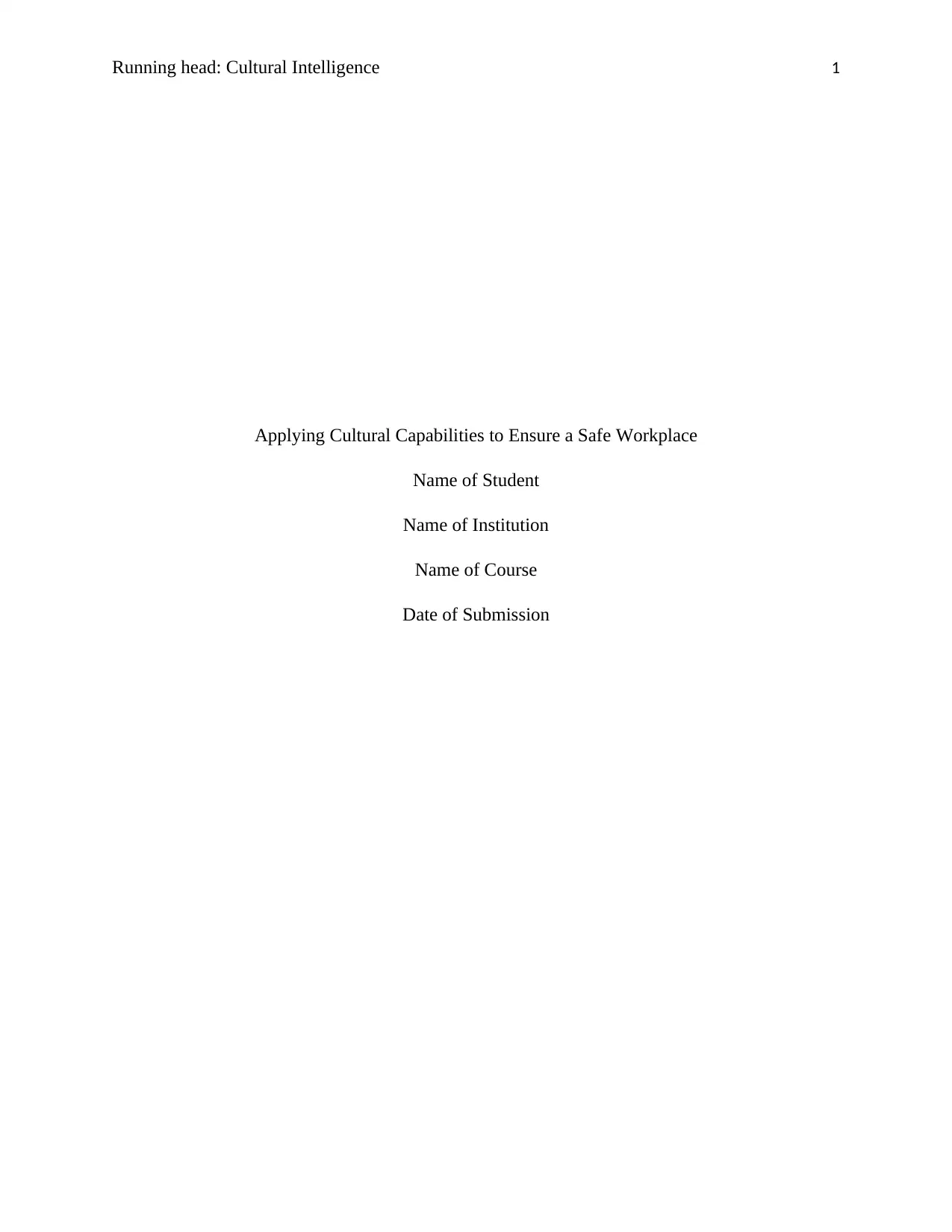
Running head: Cultural Intelligence 1
Applying Cultural Capabilities to Ensure a Safe Workplace
Name of Student
Name of Institution
Name of Course
Date of Submission
Applying Cultural Capabilities to Ensure a Safe Workplace
Name of Student
Name of Institution
Name of Course
Date of Submission
Paraphrase This Document
Need a fresh take? Get an instant paraphrase of this document with our AI Paraphraser
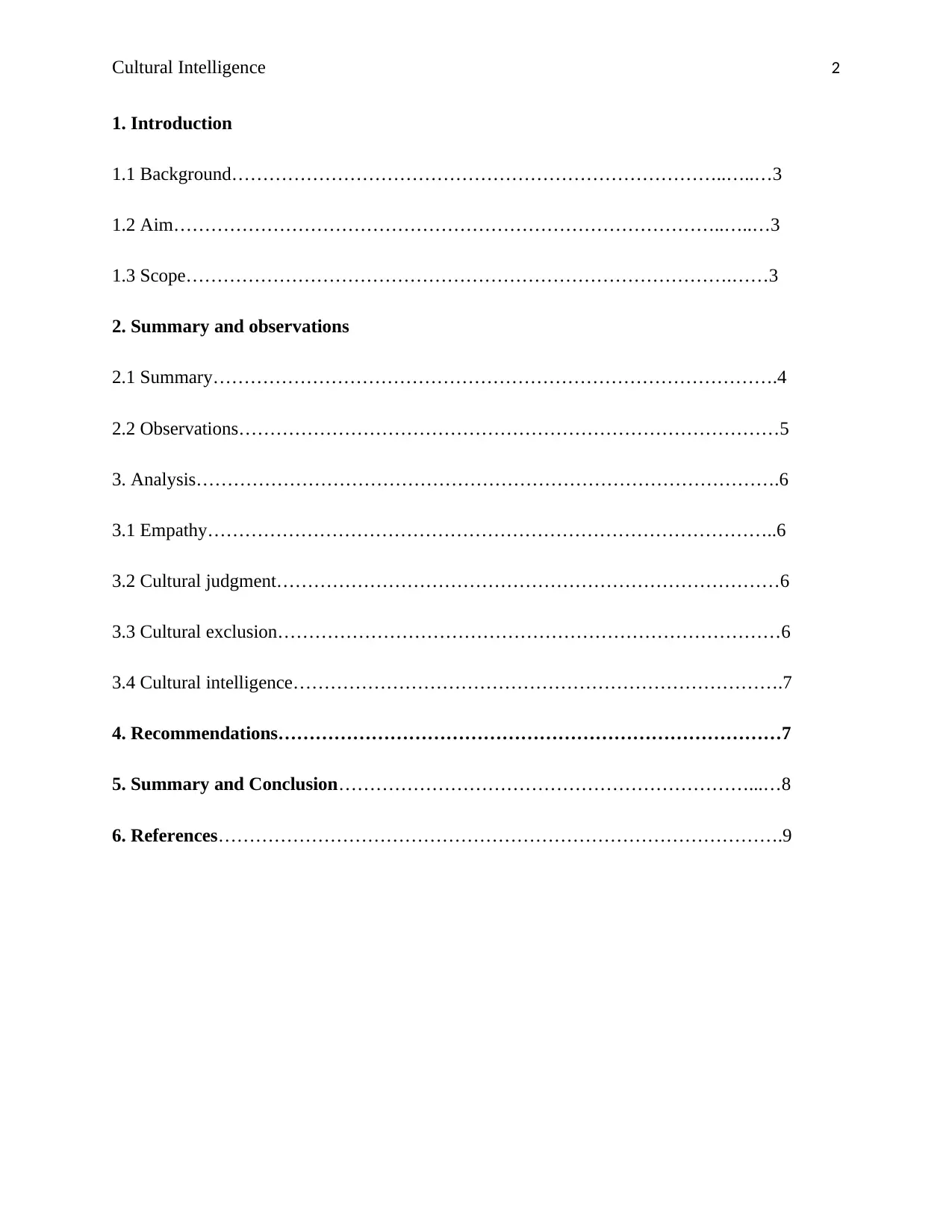
Cultural Intelligence 2
1. Introduction
1.1 Background……………………………………………………………………..…..…3
1.2 Aim……………………………………………………………………………..…..…3
1.3 Scope…………………………………………………………………………….……3
2. Summary and observations
2.1 Summary……………………………………………………………………………….4
2.2 Observations……………………………………………………………………………5
3. Analysis………………………………………………………………………………….6
3.1 Empathy………………………………………………………………………………..6
3.2 Cultural judgment………………………………………………………………………6
3.3 Cultural exclusion………………………………………………………………………6
3.4 Cultural intelligence…………………………………………………………………….7
4. Recommendations………………………………………………………………………7
5. Summary and Conclusion…………………………………………………………...…8
6. References……………………………………………………………………………….9
1. Introduction
1.1 Background……………………………………………………………………..…..…3
1.2 Aim……………………………………………………………………………..…..…3
1.3 Scope…………………………………………………………………………….……3
2. Summary and observations
2.1 Summary……………………………………………………………………………….4
2.2 Observations……………………………………………………………………………5
3. Analysis………………………………………………………………………………….6
3.1 Empathy………………………………………………………………………………..6
3.2 Cultural judgment………………………………………………………………………6
3.3 Cultural exclusion………………………………………………………………………6
3.4 Cultural intelligence…………………………………………………………………….7
4. Recommendations………………………………………………………………………7
5. Summary and Conclusion…………………………………………………………...…8
6. References……………………………………………………………………………….9
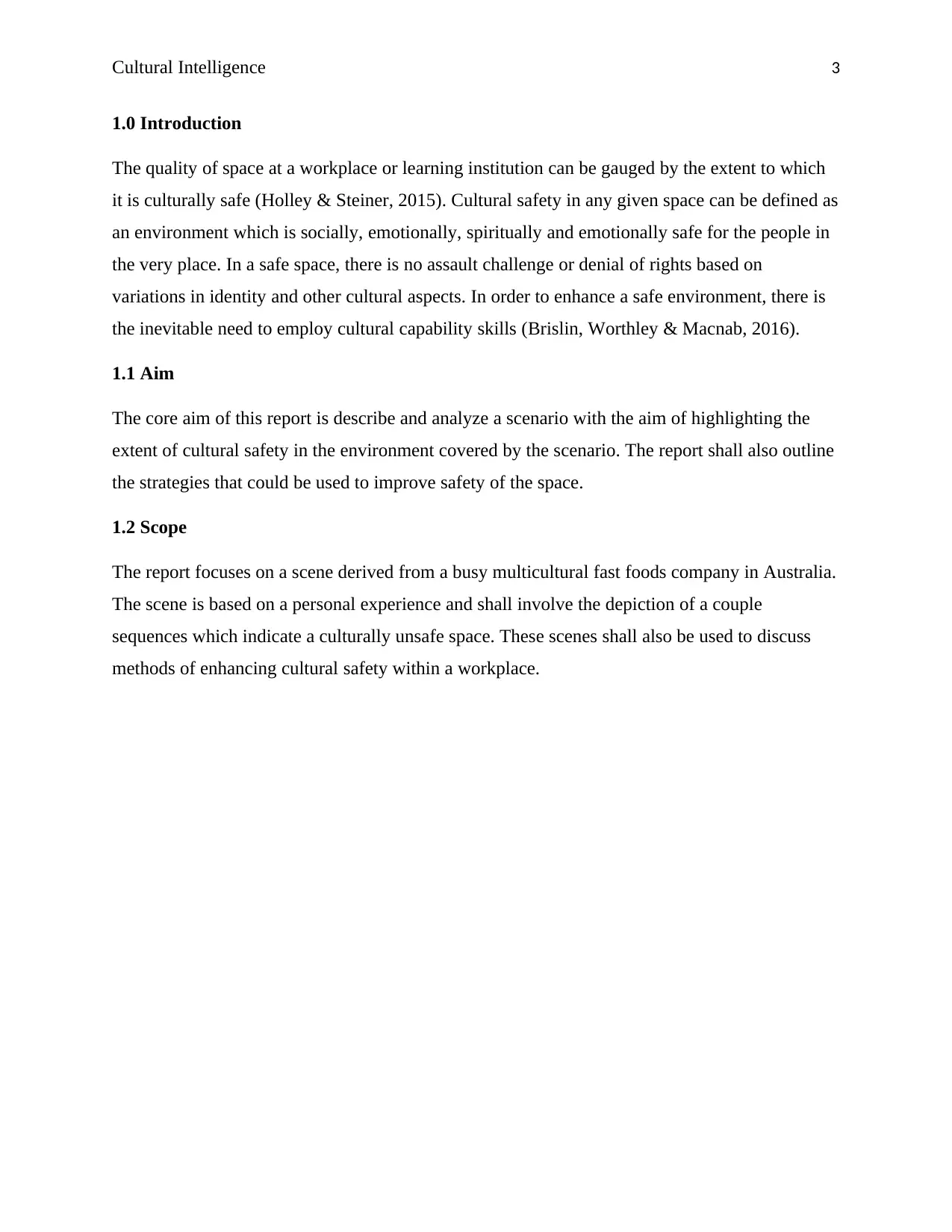
Cultural Intelligence 3
1.0 Introduction
The quality of space at a workplace or learning institution can be gauged by the extent to which
it is culturally safe (Holley & Steiner, 2015). Cultural safety in any given space can be defined as
an environment which is socially, emotionally, spiritually and emotionally safe for the people in
the very place. In a safe space, there is no assault challenge or denial of rights based on
variations in identity and other cultural aspects. In order to enhance a safe environment, there is
the inevitable need to employ cultural capability skills (Brislin, Worthley & Macnab, 2016).
1.1 Aim
The core aim of this report is describe and analyze a scenario with the aim of highlighting the
extent of cultural safety in the environment covered by the scenario. The report shall also outline
the strategies that could be used to improve safety of the space.
1.2 Scope
The report focuses on a scene derived from a busy multicultural fast foods company in Australia.
The scene is based on a personal experience and shall involve the depiction of a couple
sequences which indicate a culturally unsafe space. These scenes shall also be used to discuss
methods of enhancing cultural safety within a workplace.
1.0 Introduction
The quality of space at a workplace or learning institution can be gauged by the extent to which
it is culturally safe (Holley & Steiner, 2015). Cultural safety in any given space can be defined as
an environment which is socially, emotionally, spiritually and emotionally safe for the people in
the very place. In a safe space, there is no assault challenge or denial of rights based on
variations in identity and other cultural aspects. In order to enhance a safe environment, there is
the inevitable need to employ cultural capability skills (Brislin, Worthley & Macnab, 2016).
1.1 Aim
The core aim of this report is describe and analyze a scenario with the aim of highlighting the
extent of cultural safety in the environment covered by the scenario. The report shall also outline
the strategies that could be used to improve safety of the space.
1.2 Scope
The report focuses on a scene derived from a busy multicultural fast foods company in Australia.
The scene is based on a personal experience and shall involve the depiction of a couple
sequences which indicate a culturally unsafe space. These scenes shall also be used to discuss
methods of enhancing cultural safety within a workplace.
⊘ This is a preview!⊘
Do you want full access?
Subscribe today to unlock all pages.

Trusted by 1+ million students worldwide
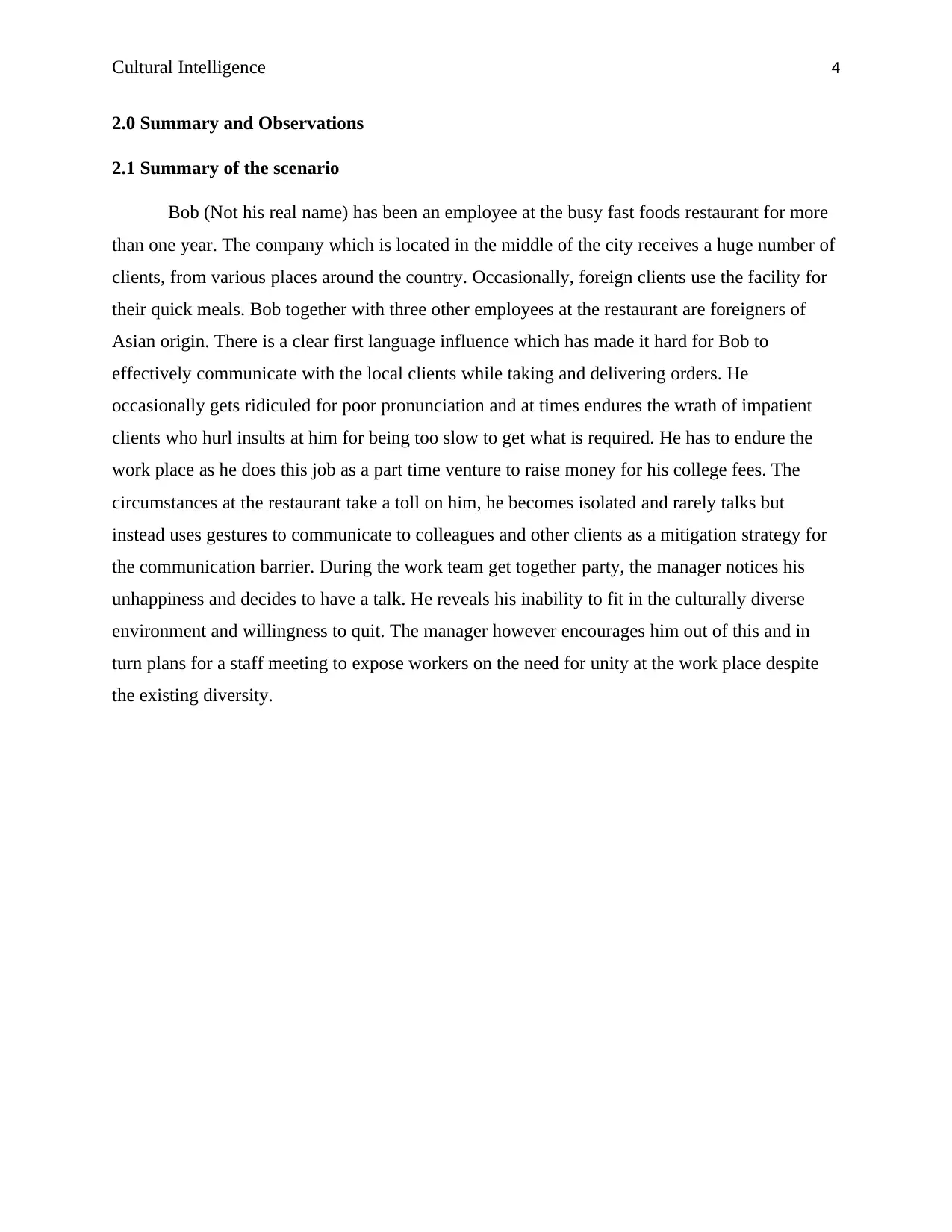
Cultural Intelligence 4
2.0 Summary and Observations
2.1 Summary of the scenario
Bob (Not his real name) has been an employee at the busy fast foods restaurant for more
than one year. The company which is located in the middle of the city receives a huge number of
clients, from various places around the country. Occasionally, foreign clients use the facility for
their quick meals. Bob together with three other employees at the restaurant are foreigners of
Asian origin. There is a clear first language influence which has made it hard for Bob to
effectively communicate with the local clients while taking and delivering orders. He
occasionally gets ridiculed for poor pronunciation and at times endures the wrath of impatient
clients who hurl insults at him for being too slow to get what is required. He has to endure the
work place as he does this job as a part time venture to raise money for his college fees. The
circumstances at the restaurant take a toll on him, he becomes isolated and rarely talks but
instead uses gestures to communicate to colleagues and other clients as a mitigation strategy for
the communication barrier. During the work team get together party, the manager notices his
unhappiness and decides to have a talk. He reveals his inability to fit in the culturally diverse
environment and willingness to quit. The manager however encourages him out of this and in
turn plans for a staff meeting to expose workers on the need for unity at the work place despite
the existing diversity.
2.0 Summary and Observations
2.1 Summary of the scenario
Bob (Not his real name) has been an employee at the busy fast foods restaurant for more
than one year. The company which is located in the middle of the city receives a huge number of
clients, from various places around the country. Occasionally, foreign clients use the facility for
their quick meals. Bob together with three other employees at the restaurant are foreigners of
Asian origin. There is a clear first language influence which has made it hard for Bob to
effectively communicate with the local clients while taking and delivering orders. He
occasionally gets ridiculed for poor pronunciation and at times endures the wrath of impatient
clients who hurl insults at him for being too slow to get what is required. He has to endure the
work place as he does this job as a part time venture to raise money for his college fees. The
circumstances at the restaurant take a toll on him, he becomes isolated and rarely talks but
instead uses gestures to communicate to colleagues and other clients as a mitigation strategy for
the communication barrier. During the work team get together party, the manager notices his
unhappiness and decides to have a talk. He reveals his inability to fit in the culturally diverse
environment and willingness to quit. The manager however encourages him out of this and in
turn plans for a staff meeting to expose workers on the need for unity at the work place despite
the existing diversity.
Paraphrase This Document
Need a fresh take? Get an instant paraphrase of this document with our AI Paraphraser
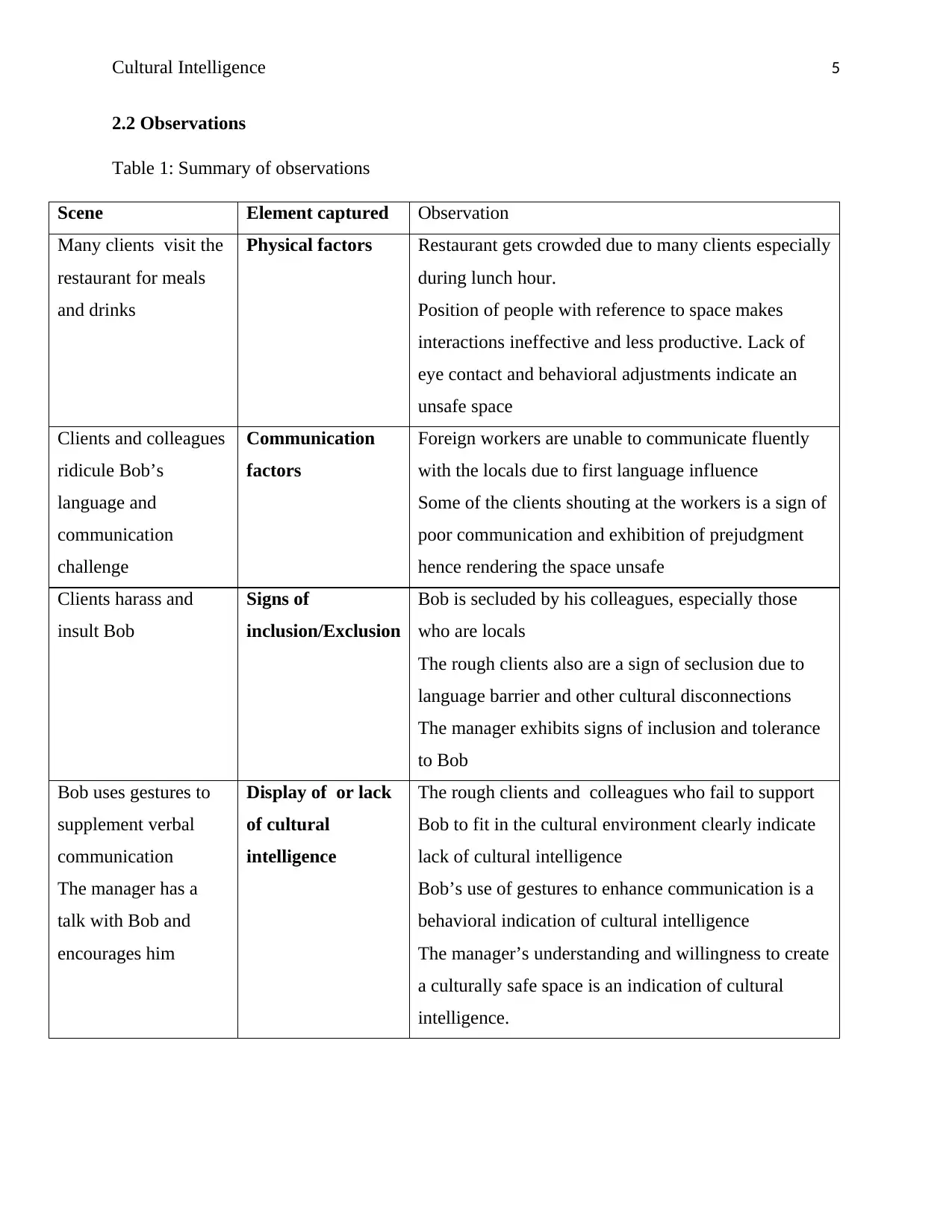
Cultural Intelligence 5
2.2 Observations
Table 1: Summary of observations
Scene Element captured Observation
Many clients visit the
restaurant for meals
and drinks
Physical factors Restaurant gets crowded due to many clients especially
during lunch hour.
Position of people with reference to space makes
interactions ineffective and less productive. Lack of
eye contact and behavioral adjustments indicate an
unsafe space
Clients and colleagues
ridicule Bob’s
language and
communication
challenge
Communication
factors
Foreign workers are unable to communicate fluently
with the locals due to first language influence
Some of the clients shouting at the workers is a sign of
poor communication and exhibition of prejudgment
hence rendering the space unsafe
Clients harass and
insult Bob
Signs of
inclusion/Exclusion
Bob is secluded by his colleagues, especially those
who are locals
The rough clients also are a sign of seclusion due to
language barrier and other cultural disconnections
The manager exhibits signs of inclusion and tolerance
to Bob
Bob uses gestures to
supplement verbal
communication
The manager has a
talk with Bob and
encourages him
Display of or lack
of cultural
intelligence
The rough clients and colleagues who fail to support
Bob to fit in the cultural environment clearly indicate
lack of cultural intelligence
Bob’s use of gestures to enhance communication is a
behavioral indication of cultural intelligence
The manager’s understanding and willingness to create
a culturally safe space is an indication of cultural
intelligence.
2.2 Observations
Table 1: Summary of observations
Scene Element captured Observation
Many clients visit the
restaurant for meals
and drinks
Physical factors Restaurant gets crowded due to many clients especially
during lunch hour.
Position of people with reference to space makes
interactions ineffective and less productive. Lack of
eye contact and behavioral adjustments indicate an
unsafe space
Clients and colleagues
ridicule Bob’s
language and
communication
challenge
Communication
factors
Foreign workers are unable to communicate fluently
with the locals due to first language influence
Some of the clients shouting at the workers is a sign of
poor communication and exhibition of prejudgment
hence rendering the space unsafe
Clients harass and
insult Bob
Signs of
inclusion/Exclusion
Bob is secluded by his colleagues, especially those
who are locals
The rough clients also are a sign of seclusion due to
language barrier and other cultural disconnections
The manager exhibits signs of inclusion and tolerance
to Bob
Bob uses gestures to
supplement verbal
communication
The manager has a
talk with Bob and
encourages him
Display of or lack
of cultural
intelligence
The rough clients and colleagues who fail to support
Bob to fit in the cultural environment clearly indicate
lack of cultural intelligence
Bob’s use of gestures to enhance communication is a
behavioral indication of cultural intelligence
The manager’s understanding and willingness to create
a culturally safe space is an indication of cultural
intelligence.
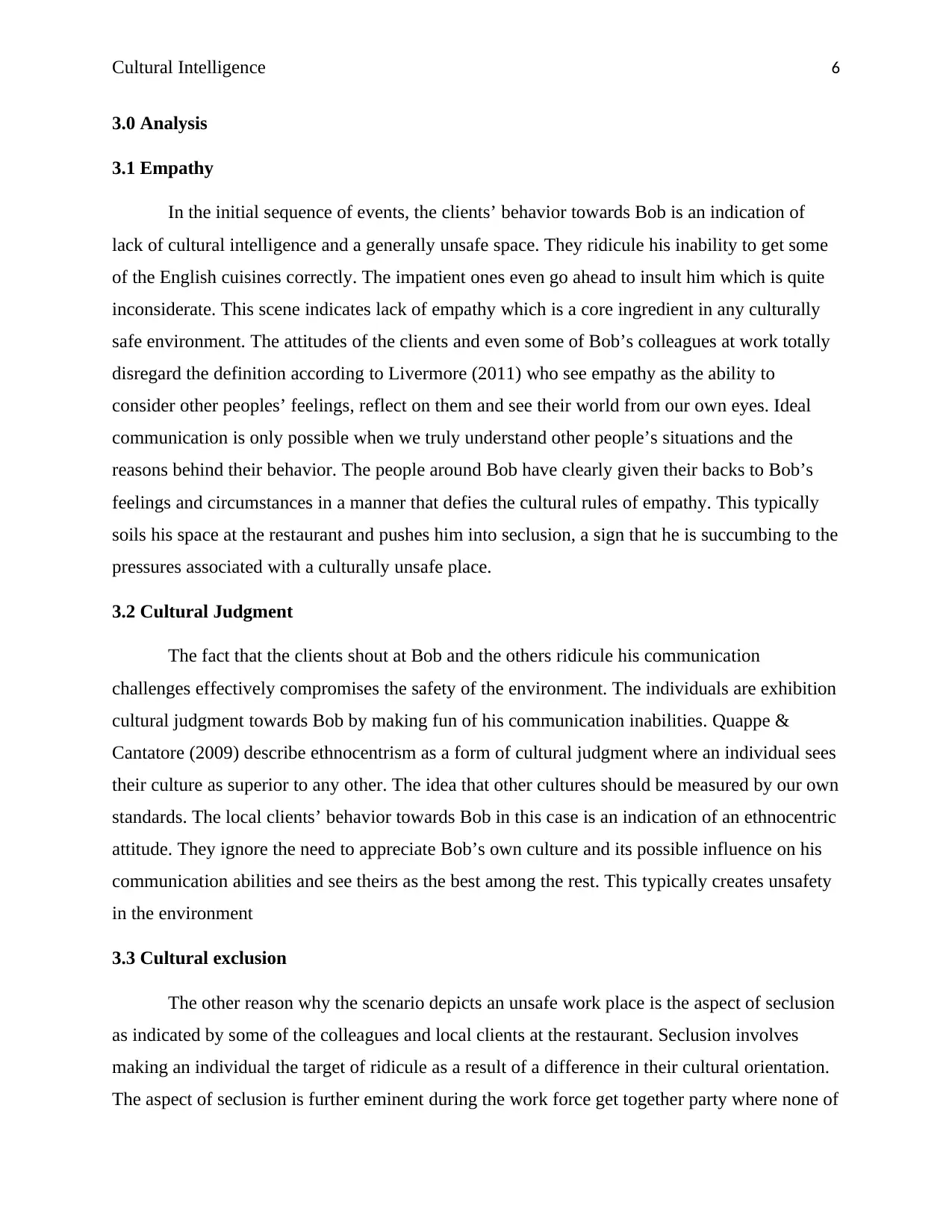
Cultural Intelligence 6
3.0 Analysis
3.1 Empathy
In the initial sequence of events, the clients’ behavior towards Bob is an indication of
lack of cultural intelligence and a generally unsafe space. They ridicule his inability to get some
of the English cuisines correctly. The impatient ones even go ahead to insult him which is quite
inconsiderate. This scene indicates lack of empathy which is a core ingredient in any culturally
safe environment. The attitudes of the clients and even some of Bob’s colleagues at work totally
disregard the definition according to Livermore (2011) who see empathy as the ability to
consider other peoples’ feelings, reflect on them and see their world from our own eyes. Ideal
communication is only possible when we truly understand other people’s situations and the
reasons behind their behavior. The people around Bob have clearly given their backs to Bob’s
feelings and circumstances in a manner that defies the cultural rules of empathy. This typically
soils his space at the restaurant and pushes him into seclusion, a sign that he is succumbing to the
pressures associated with a culturally unsafe place.
3.2 Cultural Judgment
The fact that the clients shout at Bob and the others ridicule his communication
challenges effectively compromises the safety of the environment. The individuals are exhibition
cultural judgment towards Bob by making fun of his communication inabilities. Quappe &
Cantatore (2009) describe ethnocentrism as a form of cultural judgment where an individual sees
their culture as superior to any other. The idea that other cultures should be measured by our own
standards. The local clients’ behavior towards Bob in this case is an indication of an ethnocentric
attitude. They ignore the need to appreciate Bob’s own culture and its possible influence on his
communication abilities and see theirs as the best among the rest. This typically creates unsafety
in the environment
3.3 Cultural exclusion
The other reason why the scenario depicts an unsafe work place is the aspect of seclusion
as indicated by some of the colleagues and local clients at the restaurant. Seclusion involves
making an individual the target of ridicule as a result of a difference in their cultural orientation.
The aspect of seclusion is further eminent during the work force get together party where none of
3.0 Analysis
3.1 Empathy
In the initial sequence of events, the clients’ behavior towards Bob is an indication of
lack of cultural intelligence and a generally unsafe space. They ridicule his inability to get some
of the English cuisines correctly. The impatient ones even go ahead to insult him which is quite
inconsiderate. This scene indicates lack of empathy which is a core ingredient in any culturally
safe environment. The attitudes of the clients and even some of Bob’s colleagues at work totally
disregard the definition according to Livermore (2011) who see empathy as the ability to
consider other peoples’ feelings, reflect on them and see their world from our own eyes. Ideal
communication is only possible when we truly understand other people’s situations and the
reasons behind their behavior. The people around Bob have clearly given their backs to Bob’s
feelings and circumstances in a manner that defies the cultural rules of empathy. This typically
soils his space at the restaurant and pushes him into seclusion, a sign that he is succumbing to the
pressures associated with a culturally unsafe place.
3.2 Cultural Judgment
The fact that the clients shout at Bob and the others ridicule his communication
challenges effectively compromises the safety of the environment. The individuals are exhibition
cultural judgment towards Bob by making fun of his communication inabilities. Quappe &
Cantatore (2009) describe ethnocentrism as a form of cultural judgment where an individual sees
their culture as superior to any other. The idea that other cultures should be measured by our own
standards. The local clients’ behavior towards Bob in this case is an indication of an ethnocentric
attitude. They ignore the need to appreciate Bob’s own culture and its possible influence on his
communication abilities and see theirs as the best among the rest. This typically creates unsafety
in the environment
3.3 Cultural exclusion
The other reason why the scenario depicts an unsafe work place is the aspect of seclusion
as indicated by some of the colleagues and local clients at the restaurant. Seclusion involves
making an individual the target of ridicule as a result of a difference in their cultural orientation.
The aspect of seclusion is further eminent during the work force get together party where none of
⊘ This is a preview!⊘
Do you want full access?
Subscribe today to unlock all pages.

Trusted by 1+ million students worldwide
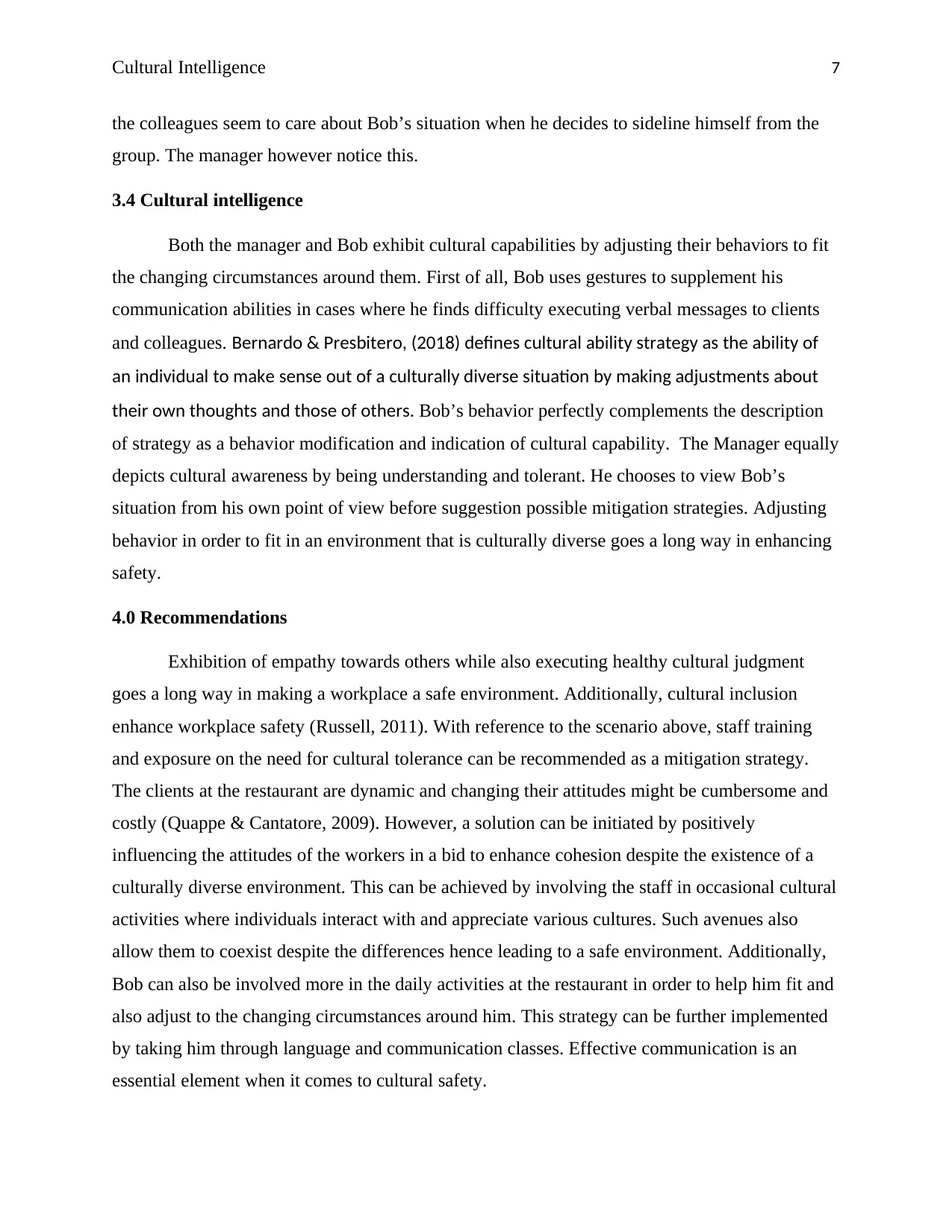
Cultural Intelligence 7
the colleagues seem to care about Bob’s situation when he decides to sideline himself from the
group. The manager however notice this.
3.4 Cultural intelligence
Both the manager and Bob exhibit cultural capabilities by adjusting their behaviors to fit
the changing circumstances around them. First of all, Bob uses gestures to supplement his
communication abilities in cases where he finds difficulty executing verbal messages to clients
and colleagues. Bernardo & Presbitero, (2018) defines cultural ability strategy as the ability of
an individual to make sense out of a culturally diverse situation by making adjustments about
their own thoughts and those of others. Bob’s behavior perfectly complements the description
of strategy as a behavior modification and indication of cultural capability. The Manager equally
depicts cultural awareness by being understanding and tolerant. He chooses to view Bob’s
situation from his own point of view before suggestion possible mitigation strategies. Adjusting
behavior in order to fit in an environment that is culturally diverse goes a long way in enhancing
safety.
4.0 Recommendations
Exhibition of empathy towards others while also executing healthy cultural judgment
goes a long way in making a workplace a safe environment. Additionally, cultural inclusion
enhance workplace safety (Russell, 2011). With reference to the scenario above, staff training
and exposure on the need for cultural tolerance can be recommended as a mitigation strategy.
The clients at the restaurant are dynamic and changing their attitudes might be cumbersome and
costly (Quappe & Cantatore, 2009). However, a solution can be initiated by positively
influencing the attitudes of the workers in a bid to enhance cohesion despite the existence of a
culturally diverse environment. This can be achieved by involving the staff in occasional cultural
activities where individuals interact with and appreciate various cultures. Such avenues also
allow them to coexist despite the differences hence leading to a safe environment. Additionally,
Bob can also be involved more in the daily activities at the restaurant in order to help him fit and
also adjust to the changing circumstances around him. This strategy can be further implemented
by taking him through language and communication classes. Effective communication is an
essential element when it comes to cultural safety.
the colleagues seem to care about Bob’s situation when he decides to sideline himself from the
group. The manager however notice this.
3.4 Cultural intelligence
Both the manager and Bob exhibit cultural capabilities by adjusting their behaviors to fit
the changing circumstances around them. First of all, Bob uses gestures to supplement his
communication abilities in cases where he finds difficulty executing verbal messages to clients
and colleagues. Bernardo & Presbitero, (2018) defines cultural ability strategy as the ability of
an individual to make sense out of a culturally diverse situation by making adjustments about
their own thoughts and those of others. Bob’s behavior perfectly complements the description
of strategy as a behavior modification and indication of cultural capability. The Manager equally
depicts cultural awareness by being understanding and tolerant. He chooses to view Bob’s
situation from his own point of view before suggestion possible mitigation strategies. Adjusting
behavior in order to fit in an environment that is culturally diverse goes a long way in enhancing
safety.
4.0 Recommendations
Exhibition of empathy towards others while also executing healthy cultural judgment
goes a long way in making a workplace a safe environment. Additionally, cultural inclusion
enhance workplace safety (Russell, 2011). With reference to the scenario above, staff training
and exposure on the need for cultural tolerance can be recommended as a mitigation strategy.
The clients at the restaurant are dynamic and changing their attitudes might be cumbersome and
costly (Quappe & Cantatore, 2009). However, a solution can be initiated by positively
influencing the attitudes of the workers in a bid to enhance cohesion despite the existence of a
culturally diverse environment. This can be achieved by involving the staff in occasional cultural
activities where individuals interact with and appreciate various cultures. Such avenues also
allow them to coexist despite the differences hence leading to a safe environment. Additionally,
Bob can also be involved more in the daily activities at the restaurant in order to help him fit and
also adjust to the changing circumstances around him. This strategy can be further implemented
by taking him through language and communication classes. Effective communication is an
essential element when it comes to cultural safety.
Paraphrase This Document
Need a fresh take? Get an instant paraphrase of this document with our AI Paraphraser
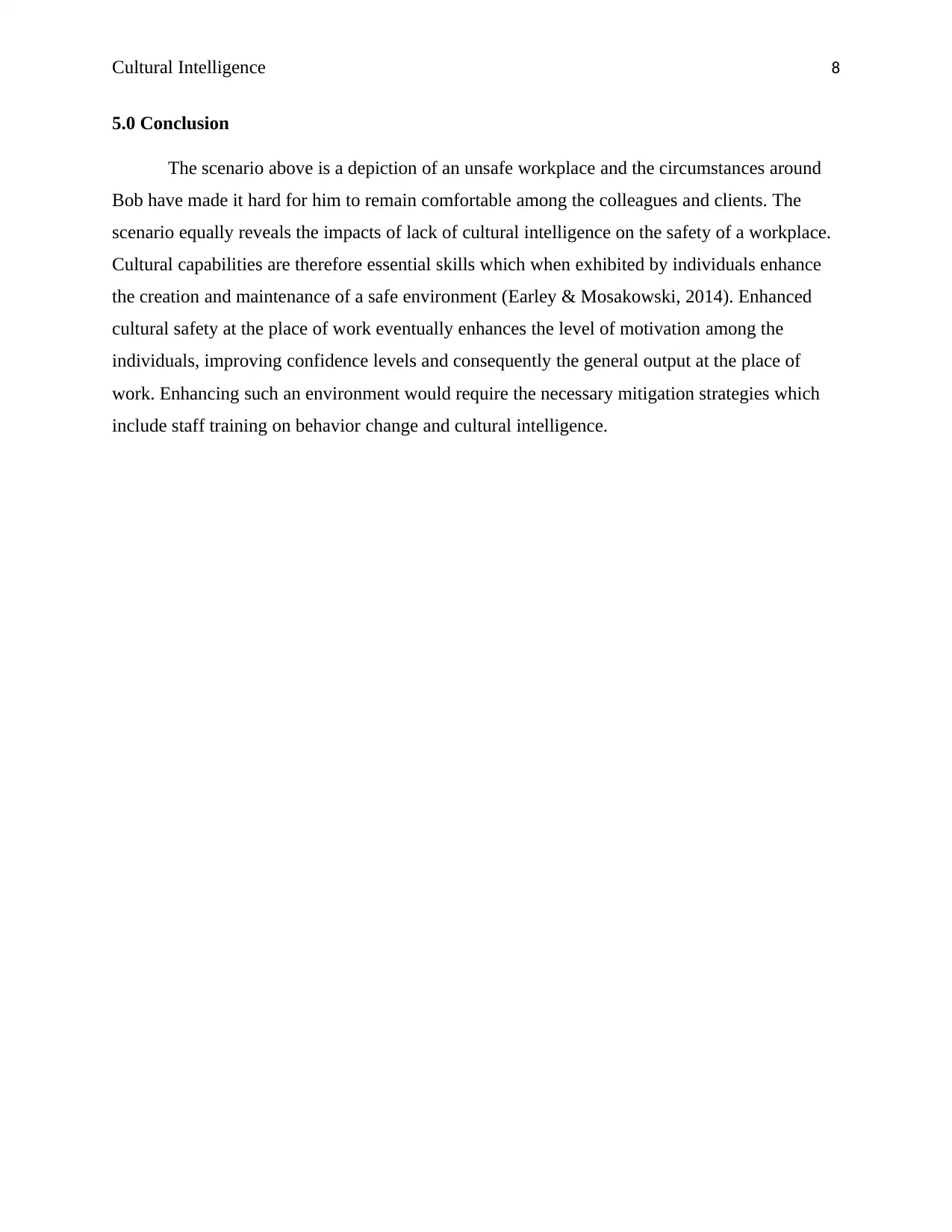
Cultural Intelligence 8
5.0 Conclusion
The scenario above is a depiction of an unsafe workplace and the circumstances around
Bob have made it hard for him to remain comfortable among the colleagues and clients. The
scenario equally reveals the impacts of lack of cultural intelligence on the safety of a workplace.
Cultural capabilities are therefore essential skills which when exhibited by individuals enhance
the creation and maintenance of a safe environment (Earley & Mosakowski, 2014). Enhanced
cultural safety at the place of work eventually enhances the level of motivation among the
individuals, improving confidence levels and consequently the general output at the place of
work. Enhancing such an environment would require the necessary mitigation strategies which
include staff training on behavior change and cultural intelligence.
5.0 Conclusion
The scenario above is a depiction of an unsafe workplace and the circumstances around
Bob have made it hard for him to remain comfortable among the colleagues and clients. The
scenario equally reveals the impacts of lack of cultural intelligence on the safety of a workplace.
Cultural capabilities are therefore essential skills which when exhibited by individuals enhance
the creation and maintenance of a safe environment (Earley & Mosakowski, 2014). Enhanced
cultural safety at the place of work eventually enhances the level of motivation among the
individuals, improving confidence levels and consequently the general output at the place of
work. Enhancing such an environment would require the necessary mitigation strategies which
include staff training on behavior change and cultural intelligence.
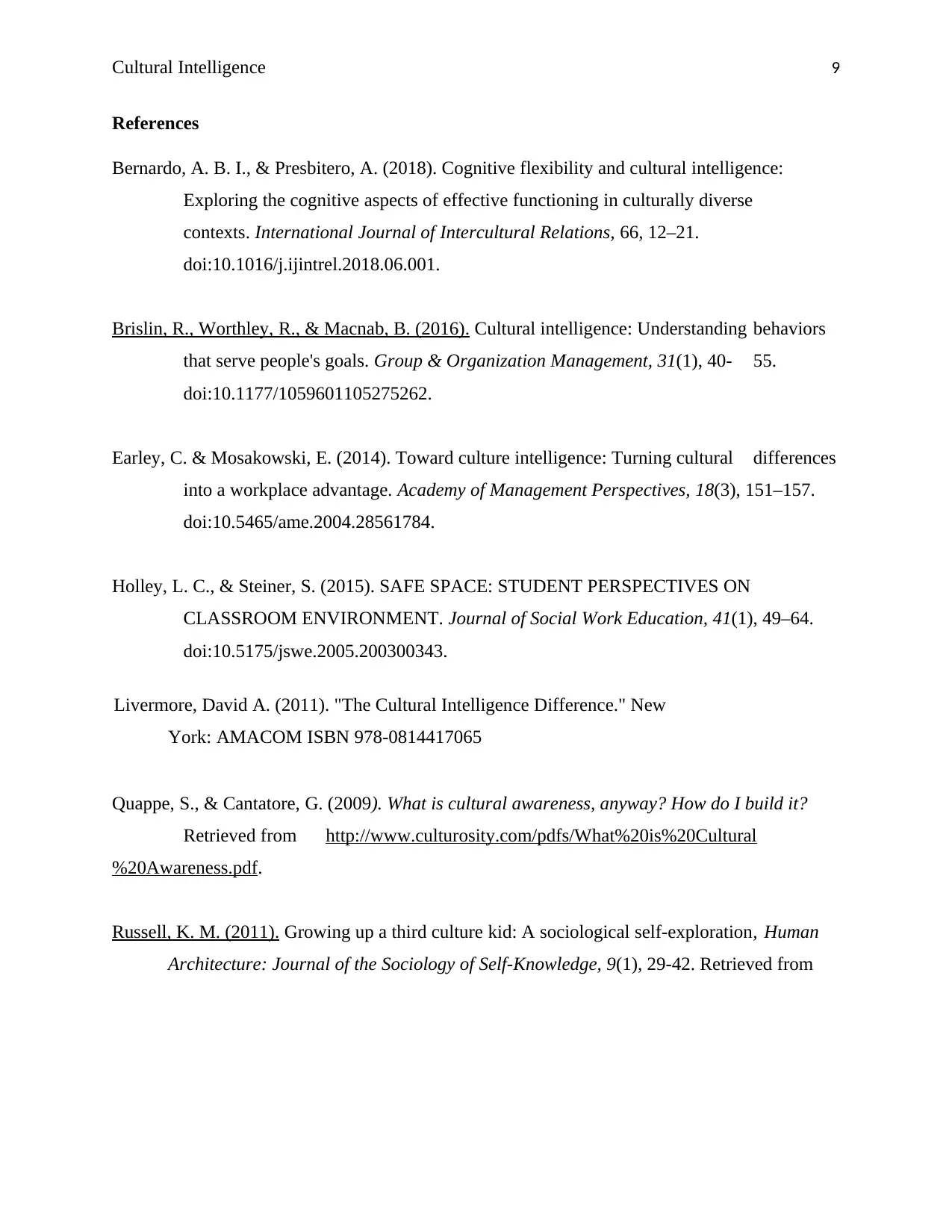
Cultural Intelligence 9
References
Bernardo, A. B. I., & Presbitero, A. (2018). Cognitive flexibility and cultural intelligence:
Exploring the cognitive aspects of effective functioning in culturally diverse
contexts. International Journal of Intercultural Relations, 66, 12–21.
doi:10.1016/j.ijintrel.2018.06.001.
Brislin, R., Worthley, R., & Macnab, B. (2016). Cultural intelligence: Understanding behaviors
that serve people's goals. Group & Organization Management, 31(1), 40- 55.
doi:10.1177/1059601105275262.
Earley, C. & Mosakowski, E. (2014). Toward culture intelligence: Turning cultural differences
into a workplace advantage. Academy of Management Perspectives, 18(3), 151–157.
doi:10.5465/ame.2004.28561784.
Holley, L. C., & Steiner, S. (2015). SAFE SPACE: STUDENT PERSPECTIVES ON
CLASSROOM ENVIRONMENT. Journal of Social Work Education, 41(1), 49–64.
doi:10.5175/jswe.2005.200300343.
Livermore, David A. (2011). "The Cultural Intelligence Difference." New
York: AMACOM ISBN 978-0814417065
Quappe, S., & Cantatore, G. (2009). What is cultural awareness, anyway? How do I build it?
Retrieved from http://www.culturosity.com/pdfs/What%20is%20Cultural
%20Awareness.pdf.
Russell, K. M. (2011). Growing up a third culture kid: A sociological self-exploration, Human
Architecture: Journal of the Sociology of Self-Knowledge, 9(1), 29-42. Retrieved from
References
Bernardo, A. B. I., & Presbitero, A. (2018). Cognitive flexibility and cultural intelligence:
Exploring the cognitive aspects of effective functioning in culturally diverse
contexts. International Journal of Intercultural Relations, 66, 12–21.
doi:10.1016/j.ijintrel.2018.06.001.
Brislin, R., Worthley, R., & Macnab, B. (2016). Cultural intelligence: Understanding behaviors
that serve people's goals. Group & Organization Management, 31(1), 40- 55.
doi:10.1177/1059601105275262.
Earley, C. & Mosakowski, E. (2014). Toward culture intelligence: Turning cultural differences
into a workplace advantage. Academy of Management Perspectives, 18(3), 151–157.
doi:10.5465/ame.2004.28561784.
Holley, L. C., & Steiner, S. (2015). SAFE SPACE: STUDENT PERSPECTIVES ON
CLASSROOM ENVIRONMENT. Journal of Social Work Education, 41(1), 49–64.
doi:10.5175/jswe.2005.200300343.
Livermore, David A. (2011). "The Cultural Intelligence Difference." New
York: AMACOM ISBN 978-0814417065
Quappe, S., & Cantatore, G. (2009). What is cultural awareness, anyway? How do I build it?
Retrieved from http://www.culturosity.com/pdfs/What%20is%20Cultural
%20Awareness.pdf.
Russell, K. M. (2011). Growing up a third culture kid: A sociological self-exploration, Human
Architecture: Journal of the Sociology of Self-Knowledge, 9(1), 29-42. Retrieved from
⊘ This is a preview!⊘
Do you want full access?
Subscribe today to unlock all pages.

Trusted by 1+ million students worldwide
1 out of 9
Related Documents
Your All-in-One AI-Powered Toolkit for Academic Success.
+13062052269
info@desklib.com
Available 24*7 on WhatsApp / Email
![[object Object]](/_next/static/media/star-bottom.7253800d.svg)
Unlock your academic potential
Copyright © 2020–2025 A2Z Services. All Rights Reserved. Developed and managed by ZUCOL.




